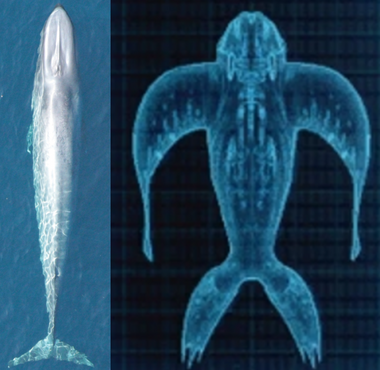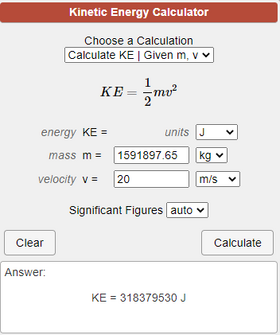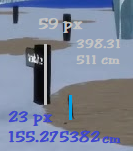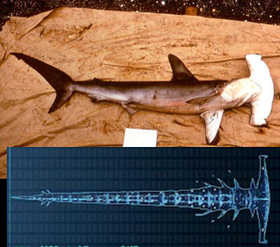I'm gonna revise the KE of various Leviathans from Subnautica, correcting some of the mistakes made here.
I'm also gonna add some Below Zero creatures since they need profiles as well.
Glow Whale[]
No calc is gonna be necessary for the Glow Whale. At 30 m long, it's about as long as the longer blue whales. However, when put side by side, we see that the Leviathan is much girthier in comparison.
The blue whale is already Wall level to Wall level+ in the wiki, which should put the Glow Whale at Small Building level, since it's slightly faster and should weigh a lot more given the size difference. By virtue of size, they should also be stronger than the Rock Punchers and the Rock Punchers' rivals and neighbors, the Cryptosuchus.
With the data bank entry, I can also find the height of Robin, which will be useful in the following calculations.
Okay, so Robin is 1.55275382 m tall. It may sound short but many women, young or old, can have this height and it's perfectly normal.
Chelicerate[]
Essentially a giant shrimp, named after the chelicerata which includes jaekelopterus, the animal I'll use for this. It was 2.5 m and was estimated to weigh 180 kg.
The estimate on the wiki seems a bit small so I decided to measure it myself.
51.6996441635 m, not bad. The ones in the Void are slightly larger by an unclear amount, but the results shouldn't really change much.
(51.6996441635/2.5)^3x180 = 1591897.65 kg ("At least Class K, likely Class M" not just based on sheer mass but because it's comparable to a Reaper as well, you'll see in the next section)
Given that it fills the same role as the Reaper and moves at a similar speed, I'll use 20 m/s for the Chelicerate as well (I go more in-depth on why 20 m/s is the best number available in the next section).
318379530 J = 76.094533938815 Kilograms Of TNT (Small Building level)
I will say this fits well enough since this kind of power is standard for being able to puncture through somewhat thick metal walls, and with the Chelicerate being able to damage the Seatruck it makes sense. Also, in the original version of the game's ending, Marguerit's PRAWN suit which has the mandible of a young Chelicerate for an arm, was capable of damaging a ship, verifying this level of power for this creature. It's also stronger than the Rock Puncher so that checks out as well.
Reaper Leviathan[]
Crimson's use of an oarfish is correct, but it ignores the fact that Reapers are more bony (you actually see Reaper skeletons in the game, an oarfish's skeleton is much smaller in comparison) and much more muscular than oarfish plus that they don't share the same proportions (oarfish are not as wide in comparison to their impressive lengths). Reapers are in fact stated to be almost all muscle.
Other than oarfish, another inspiration for Reapers are marine mammals, specifically cetaceans and dolphins. A fairly muscular species among these is the beluga whale, which I'll use as a way to consider the Reaper's more muscular build and skeletal structure. Similar to Reapers, Beluga whales have interestingly and fairly muscular bodies. Despite this, I'll still use a relatively slim and small species of dolphin, the Australian Humpback Dolphin, to take the Reaper's dolphin-like but also snake-like body shape into more account.
Reaper Leviathan: 55 m
Australian humpback dolphin: 2.75 m and 260kg
Giant oarfish: 9 m and 300 kg (In the other blog it says a 3 meter oarfish can weigh 270 kg, but this isn't correct based on other individuals)
Beluga whale: 5.5 m and 1600 kg
Square-cube law: (55/2.75)^3x260 = 2080000
Square-cube law: (55/9)^3x300 = 68467.0781893 kg
Square-cube law: (55/5.5)^3x1600 = 1600000 kg
Median number between 68467.0781893, 1600000 and 2080000 = 1600000 kg (Very similar number to that other blog, but I wanted to put a little more thought into the mass of the Reaper)
Regardless of mass however, the Reaper does have a feat for Lifting Strength, it's able to move the 54 m long submarine, the Cyclops. A 50 meter long sub from the British military would place the Reaper at "At least Class K", but given that the Reaper is bigger than the Chelicerate, it's able to wrestle with others of its kind and the Cyclops is likely heavier than that sub, I'd leave the Reapers at "At least Class K, likely Class M".
Alright, the one subject I wanted to tackle ever since I saw that blog post: speed. Now, the speed given to the Reaper is not as bad as the next few creatures, in this case it's a bit too low. On a straight line, a Reaper Leviathan will almost always catch a Seamoth, the only reason the Seamoth can evade a Reaper attack is because a Reaper can't turn as well.
That being said, being able to catch a Seamoth at top speed would mean the Reaper's speed is superior to 19.49 m/s. For the sake of rounding things up, let's say it moves at 20 m/s.
Now, the KE.
320000000 Joules = 76.481835564054 Kilograms Of TNT (Small Building level)
Consistent with the Reaper that tore right through this Degasi base.
Shadow Leviathan[]
According to the data bank, it's 60+ m (I'll just stick to 60 m however). One of its major influences are lampreys, which can reach 120 cm and 2.5 kg. Another influence is the awesomely named black ghost knifefish, 5 cm long and 0.1 kg
Median numbers between 120 cm and 5 cm/2.5 kg and 0.1 kg = 62.5 cm and 1.3 kg
(6000/62.5)^3x1.3 = 1150156.8 kg, should be on the same level as the previous two since it's bigger ("At least Class K, likely Class M")
It definitely looks faster than the Reaper, especially when it charges, but we'll use 20 m/s again since there's no other way to tell.
230031360 J = 54.978814531549 Kilograms Of TNT (Small Building level)
Ice Worm[]
Up to 95 m long, the Ice Worms are closer to centipedes and other chilopods, myriapods and long bodied arthropods in terms of length compared to the creatures they're based on, bobbit worms, which can be much, much longer.
A Chinese centipede can weigh 3 grams and measure 20 cm.
Square-cube law: (95/0.2)^3x3 = 321515625 grams or 321.515625 tonnes.
They likely weigh more than this given their more armored bodies, their skeletons and their thick knife heads. Thus, we aren't done quite yet. To account for the more heavily armored body of the Ice Worm, as a high-end I'll use the biggest eurypterid and biggest aquatic arthropod, Jaekelopterus at 2.5 m long and an estimated 180 kg.
Square-cube law: (95/2.5)^3x180 = 9876960 kg or 9876.960 tonnes
Median number between 321515.625 kg and 9876960 kg = 5099237.8125 kg (Being able to move as fast as they do with this much mass and given how much ice and earth they move while burrowing, it should place them at least at Class M)
The Ice Worm's speed is a little harder to figure out, but it can cover the same distance as a Snowfox in roughly a third of the time, the Snowfox moves at 10.5 m/s making the Ice Worm at least 31.5 m/s, though this is DEFINITELY a lowball. The Ice Worm is likely one of the few giant creatures in 4546B that can legitimately cross its own body length in one or two seconds.
2529859359.7266 Joules = 604.65089859622 Kilograms Of TNT (Building level)
Stronger than the previous fellows but that's not too surprising, the Ice Worm is kind of the final boss of Below Zero and a much bigger threat.
Redo[]
I wanted to calculate the speed of this thing, it makes a semicircle as it jumps a long distance, and I can estimate the distance and the perimeter of the jump with the pillars in the area. He goes past three, and the distance between two is 31.3119934 m, so the distance between three is 62.6239868.
The video is 60 fps. He crosses that distance in 66 frames.
66/60 = 1.1 seconds.
Now to find the perimeter.
160.994 m per 1.1 seconds = 146.358182 m/s (Subsonic)
Okay, considerably faster than expected, as well as the fastest known creature in 4546B, though this doesn't surprise me, this creature is erratic as heck.
Now, for the KE.
54614666166.244 Joules = 13053.218490976 Kilograms Of TNT (City Block level)
It's able to destroy Alterra bases and smash through large ice structures so that's fair enough.
Ghost Leviathan[]
The other blog post says it's based on an eel. Kind of. It's based on eel larvae but there are no properly stated weights for these guys and either way it'd be wrong to use them since Ghost Leviathans are much sturdier creatures, with bodies and especially heads built for ramming intruders. Their "skeletons" and their translucent skin are also very different.
Regardless, I'll use electric eels as well since Ghost Leviathans are related to (and are evolved versions of) creatures that are based on them. Given the offensive build of the Ghosts, it should be fair to use them.
Electric eels are 2 m and 20 kg.
The Juvenile Ghost is estimated at 67 m and adults at 107.
Square-cube law: (67/2)^3x20 = 751907.5 kg
Square-cube law: (107/2)^3x20 = 3062607.5 kg
Not very heavy, but given their physiology, it's not too surprising
However, since they're also based on the similarly tough animals we know as hammerhead sharks, I will use them as a high-end. Specifically the smooth hammerhead, at 5 m and 400 kg.
Square-cube law: (67/5)^3x400 = 962441.6 kg
Square-cube law: (107/5)^3x400 = 3920137.6 kg
Median numbers: 751907.5 and 962441.6 = 857174.55 kg / 3062607.5 and 3920137.6 = 3491372.55 kg
Once again, using 20 m/s since even the Juveniles are much faster than the Seamoth and comparable to Reapers. But clearly not at 71.69 m/s or 114.49 m/s like the previous blog post says, because they clearly don't move fast enough to cross more than their bodylength in one second. I have to repeat it every single time, because it goes against what we see in the game and it irks me. Like, you'd NEVER escape from these predators if they were as fast as that blog post claims.
171434910 Joules = 40.973926864245 Kilograms Of TNT
698274510 Joules = 166.89161328872 Kilograms Of TNT
Both Small Building level. They are powerful predators that can and might attack and devour each other but as filter feeders, they don't require too much attack power. However, since the adult is bigger than the Ice Worm, I'd give it a "possibly City Block level".
Redo[]
I found a way to measure the adult's speed. In the dead zone where they roam, they can more or less keep up with the P.R.A.W.N. suit as it falls deeper.
Using this video as reference (apologies for the let's player in the video)
At 8:30 the suit is at 1053 m, at 8:31 it's at 1085 m.
1085 - 1053 = 32 m/s
1787582745.6 Joules = 427.24253001912 Kilograms Of TNT (Building level)
Okay, Building level is a little more believable since they can ward off anything that enters the dead zone, which would include Reapers (Sea Dragons are pretty content living in the deeper, hotter areas). Still a "possibly City Block level" given its size advantage over the Ice Worm, though.
Ventgarden[]
The juveniles are roughly 20 m long whereas the adults are estimated to be 110.
Using the barrel jellyfish as reference: one meter and up to 25 kilograms (the slight size difference should make up for the flora inside the Ventgarden, as well as its more solid hook-like limbs)
Square-cube law: (20/1)^3x25 = 200000 kg (At least Class K)
Square-cube law: (110/1)^3x25 = 33275000 kg (Class M)
The Juvenile Ventgarden move slowly, around the same speed as the average PRAWN (6 m/s). We don't see the adults move since they're always eating and stationary but we'll use that same speed.
3600000 Joules = 0.8604206500956 Kilograms Of TNT (Wall level)
598950000 Joules = 143.15248565966 Kilograms Of TNT (Small Building level)
I'd place the adults at "At least Small Building level, possibly higher" due to the fact that we don't see them move and based on how enormous they are. The Ventgarden's docile in nature but it lives in the same territory as Chelicerates, though Chelicerates can't do anything to the Ventgardens, not even move them.
Sea Dragon Leviathan[]
At 112 m long, the Sea Dragon is the biggest aggressive Leviathan in 4546B (known so far) and given its ability to hunt Reapers and destroy Precursor bases, this places it at Class M (it drags Reapers down into the depths without issue) and City Block level (Bigger and stronger than the Ice Worm, can destroy Precursor bases)
Do consider, as well, the Precursor facilities are made of materials so durable there's no known way to damage or destroy it.
| “ | Scans indicate this structure is composed of a metal alloy with unprecedented integrity. | „ |
| ~ PDA |
| “ | The facility's unknown construction material is identified as an ultra-hard, non-reactive metal amalgam, synthesized from offworld materials. There is no indication that it can be damaged or destroyed by available means. | „ |
| ~ PDA |
And keep in mind that the walls of the facility the Sea Dragon brought down had been substantially reinforced.
Sea Emperor Leviathan[]
Even bigger and stronger than the Sea Dragon, Class M and City Block level as well.
Reefbacks[]
According to the PDA:
| “ | The reefback species has likely been able to grow far larger than other herbivores because anything large enough to break through its shell has long since gone extinct. | „ |
Both the juvenile and adult Reefbacks cannot be harmed in-game as they have no death animation. While their slow speed means they aren't all that strong, their durability should put them at "City Block level", given that no extant creature on 4546B can damage them. The fact that Reapers don't hunt them and that Sea Dragons ignore them to go after Reapers actually solidifies this.
Ancient Skeleton[]
Done here, which was a bit of a lowball since the creature is stated to have been bigger than the Sea Emperor.
"At least Building level, likely City Block level", given that I'm going off assumptions and since greater size and mass almost always tends to mean you're stronger in Subnautica (as is the case in the real world), it should probably be stronger than the Worm, the Dragon or the Emperor.
Frozen Leviathan[]
Much like the previous and following Leviathans, this guy is dead, but it's thankfully closer to real life animals than most of the guys here. Its webbed feet and scutes that run down the back all the way to the tail are very reminiscent of crocodiles, even if the horns, tusks, and very different head make things a little harder. The body of the Leviathan is also much thicker in comparison.
Because of the girthy nature of the Frozen Leviathan's body, I'll use the largest confirmed crocodile in captivity, the late Lolong, at 6.17 m and 1075 kg. Even then it'll be a lowball because even Lolong isn't as thick as this Leviathan.
As the second biggest Leviathan that we know of outside of the one that follows, he measures an astounding 150 m from jaws to tail.
Square-cube law: (150/6.17)^3x1075 = 15446381.2 kg (This easily places it in the Class M category, and it likely hunted creatures of such sizes as well)
We're gonna once again assume that it moved at least at 20 m/s.
3089276240 Joules = 738.3547418738 Kilograms Of TNT (Building level)
"At least Building level, likely City Block level", given it was definitely heavier than calculated and likely moved faster than that, plus was bigger and bulkier than the Sea Dragon.
Gargantuan Fossil (Gargantuan Leviathan is a fan name)[]

While almost entirely hypothetical given that the creature is long extinct, and described as eel-like, we can tell based on the ribs and what's left of the skeleton that it was much bulkier. A viper moray eel's skeleton is nowhere near as robust, the Leviathan's actually closer to a mosasaur, more than anything else.
A Mosasaurus could be up to 17 m long and weigh up to 20 tonnes. The Gargantuan fossil is measured at 402 m long but it's only the front third, the rest is either underground or somewhere else (bitten off by an even bigger creature maybe?), meaning its total length would be around 1206 m long.
Square-cube law: (1206/17)^3x20 = 7140442.97 tonnes (This would also place it at Class G, assuming it's able to lift even 1/6 of its total mass, but being able to swim at all while carrying this much mass should guarantee this level of strength)
Since it's been dead for 3 million years, it's impossible to know how fast it was. It might've been slow moving and perhaps the extinct predator of the Reefbacks implied in their data bank entry, but since every predatory Leviathan in Subnautica thus far has been depicted as being faster than the Seamoth, let's also assume it's slightly faster than it at 20 m/s. Obviously we'll ignore the previous thread's idea that it moved at 1290.42 m/s... Only one creature in 4546B is stated to have surpassed the speed of sound, I don't believe for a second that this thing was that fast, especially when the animals in Subnautica move at fair speeds relative to their sizes .
1428088594000 J = 341.32136567878 tonnes of TNT (Multi-City Block level)
"Possibly up to Multi-City Block level" given we're mostly assuming things (even if the data is all there).
Bonus: The Floaters[]
Floaters may not look too imposing, but in the world of Subnautica, they're arguably among the deadliest creatures. Here I'll calculate the lifting power of the Floaters, and trust me, it's a lot.
Juvenile[]
First we have to find the size of the Floater.
Ryley is roughly 168 cm.
Making the Floater about 62.5234493 cm across.
Here we see two Floaters moving and carrying a rock. A few more can easily lift up rocks of this size to the surface, but generally they remain stationary in the water, floating.
Now to calculate the weight of that rock.
Density of continental crust, stone and earth: 2700 Kg/m^3
95.6765892 tonnes, but we aren't done just yet. Things weigh 1.5x less underwater according to this.
95.6765892 / 1.5 = 63.7843928 divided by two (since it was two Floaters doing this) = 31.8921964 tonnes (Class 50)
However, the fact that they can inconvenience Leviathans like the Reaper gives them a "possibly higher", since the Reaper is much bigger than a blue whale and is able to move other creatures weighing thousands of tonnes.
Adult[]
In terms of strength, the adults, known as Ancient Floaters, are miles above their babies, because they don't just keep rocks floating but entire islands.
Measuring the size of it isn't too hard a task, with the following screenshots through which I can find the volume of the whole thing, give or take a few dozen meters of land. The proportions of the island can easily be found by one of the bases in it, and I can determine how big a piece of the base is with one of the following images, which is concept art featuring Ryley.
Because the two mountains and the stalagmites under the island are hard to measure, I'll just ignore them and keep this lowballed. I'm already ignoring a lot of land, so keep that in mind.
1972731.02 tonnes, which would be Class G but the island is being supported at the surface by many Floaters of different ages and sizes so some are stronger than others, however that much weight divided by eight (the number of Floaters under the island as far as I'm aware) would be 246591.3775 tonnes (Class M). They are on this level of strength by virtue of size regardless, and especially if they're capable of overpowering Leviathans like the PDA says.
But we aren't done just yet.
Smaller Ancient Floaters keep floating islands underwater, and using the PDA scan on their entry, we can find how much these particular Floaters are holding.
Even the smaller Ancient Floaters are similar to the Cyclops in length, so I'll use 54 m, the length of the Cyclops, as the diameter for these three Floaters.
So this particular island weighs 23974585.7 tonnes. However, it's underwater so we divide it by 1.5 and then by 3 since there are three Floaters which leaves us with 5327685.71111 tonnes (Class G)
So Ancient Floaters are Class M to Class G, seems fair given their ability to lift islands (the PDA hints that other land masses have been lifted by them).
This only scales to them, they can't be harmed by anything and as far as we know they have no predators in the game.
Bonus 2: Stalkers' Lifting Strength & Ryley isn't a 100-tonner[]
Stalkers can pick up large cube-like chunks of titanium from the Aurora.
Titanium density: 4.506 g/cc
2.0501484 / 1.5 (weighs this less underwater) = 1.3667656 tonnes (Class 5)
Stalkers do this pretty easily, and it should scale to their larger terrestrial cousins as well as similarly sized or bigger animals, like Sand Sharks, Bone Sharks or Brute Sharks.
It also scales to Ryley since he can pick up metal salvage like the one the Stalker is holding there.
In his profile, Ryley is Class 100 because apparently he can resist the jaws of a Reaper and a Reaper's jaws pack this much force... Uh, no. He can't, Ryley isn't depicted as being that strong in-game. The Reaper can bite a few times then uses its claws to bite down on Ryley, killing him with Ryley standing absolutely no chance of taking on these enormous jaws. He only does this kind of thing against the Crabsnake which is nowhere near as strong as a Reaper.
The P.R.A.W.N. suit is another story, but Ryley isn't a 100-tonner.
Final Tally[]
- Glow Whale is likely Small Building level
- The Chelicerate, the Reaper Leviathan, the Juvenile Ghost Leviathans and the Shadow Leviathan are at least Small Building level and "At least Class K, likely Class M"
- The Adult Ghost Leviathan is Class M and "At least Building level, possibly City Block level"
- The Juvenile Ventgarden is "At least Wall level" and Class K. The adult is "At least Small Building level, possibly higher" and Class M.
- The Ice Worm is Class M and City Block level, the Sea Dragon and the Sea Emperor are "At least City Block level" as well by virtue of being by far the strongest extant species on the planet.
- The Frozen and Ancient Leviathans get "At least Building level, likely City Block level"
- The Gargantuan Leviathan get "Possibly up to Multi-City Block level" and Class G
- Reefbacks get City Block level durability
- The Floaters get "At least Class 50, possibly higher" Lifting Strength, while the Ancient Floaters are "Class M to Class G".
- Ryley, Stalkers and similarly-sized predators are Class 5
















































